|
 Current feedback circuit topology assures great sound and stable operation Current feedback circuit topology assures great sound and stable operation |
 Printed circuit boards using Teflon base Printed circuit boards using Teflon base |
 Fully modular construction with separate units for all amplifier stages Fully modular construction with separate units for all amplifier stages |
 Four-gang volume control with CP resistor elements Four-gang volume control with CP resistor elements |
 Amorphous-core power transformers Amorphous-core power transformers |
 Logic-controlled relays for short signal paths Logic-controlled relays for short signal paths |
 Optional analog recordplayback capability Optional analog recordplayback capability |
 Exquisite persimmons wood cabinet Exquisite persimmons wood cabinet |
|
A new chapter in analog excellence - The ultimate analog preamplifier with current feedback design. Teflon-base printed circuit boards assure optimum performance and reliability. High-quality four-gang volume control uses CP elements. Fully dual-mono construction with separate amorphous-core power transformers for left and right channels. Optional phono equalizer unit allows top-quality analog disc reproduction.
The C-290V is based on balanced signal transmission technology originally introduced with the C-290 . It also makes use of the current feedback principle developed by Accuphase and highly praised throughout the audio world for its superb performance and sound quality. All circuit aspects were further refined and brought to an even higher level of perfection. All circuit parts and components were individually selected on the basis of their sonic properties. The result is an analog preamplifier that stands at the very pinnacle of its field.
In its standard configuration, the C-290V is a pure line-level amplifier, but by installing the optional phono equalizer unit AD-290V, it allows top-grade analog disc reproduction as well. The balanced output stage employs complementary bridged feedback which allows total isolation from the ground line. The printed circuit boards which play a very important role in the sound of a preamplifier are made from a Teflon material (glass fluorocarbon resin) with low dielectric constant and low loss. Gold-plating of all signal traces further improves reliability and signal purity for optimum sound.
The four modules which house the line input and balanced output circuitry use specially thick aluminum with high rigidity. The modules are arranged on a motherboard firmly mounted to a hard aluminum chassis for electrical isolation and mechanical vibration suppression. Complete dual-mono construction with separate power transformers and filtering capacitors reliably prevents any unwanted interaction between the two stereo channels.
The core of the power transformers is made of an amorphous alloy core with outstanding frequency characteristics. The volume control which is another important aspect is a four-gang type which uses CP (conductive plastic) resistor elements for exceptionally clean sound. Hermetically sealed, logic-controlled relays at strategic locations make it possible to keep signal paths extremely short. Every single part and every choice of material serves one overriding goal: to reproduce music with the true splendor of a live performance.
Current feedback topology prevents phase shifts
The amplifying circuits in the C-290V use the current feedback method for
negative feedback. The operating principle is shown in Figure 2. At the
input point of the feedback loop, the impedance is kept low and current
detection is performed. A trans-impedance amplifier then converts the current
into a voltage to be used as the feedback signal. Since the impedance at
the current feedback point (current adder in Figure 2) is very low, there
is almost no phase shift.
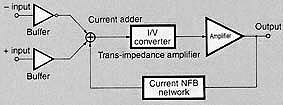
Figure 2
|
| Phase compensation therefore can be kept at a minimum. A minimal amount
of NFB results in maximum improvement of circuit parameters. The result
is excellent transient response and superb sonic transparency, coupled
with utterly natural energy balance. Figure 3 shows frequency response
for different gain settings of the current feedback amplifier. The graphs
demonstrate that response remains uniform over a wide range. |
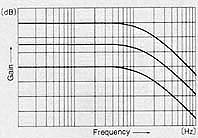
Figure 3
|
Balanced output stage with bridged feedback
In balanced signal transmission, two identical signals are transmitted
simultaneously with inverted phase and combined at the receiving end, thereby
canceling out common-mode noise and interference. This principle is one
of the requirements for truly high-quality sound. The principle of balanced
sound transmission is shown in Figure 4. The outputs of the two amplifiers
AMP2 and AMP3 are connected to form a cross-feedback loop, which sends
the symmetrical (+) and (-) signals with low impedance to the next stage.
The signals are isolated from the ground line, resulting in an ideal balanced
circuit. Even if one side of the output is grounded, both amplifiers continue
to operate, and the output voltage does not change.
|
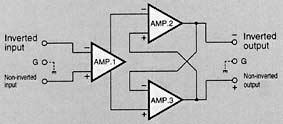
Figure 4
|
Discrete line amplifier designed for sound quality
The line amplifier is a pure complementary push-pull circuit. It is built
from discrete components and employs the superior current feedback principle.
Phase compensation can be kept to a minimum, resulting in realistic ambience.
Printed circuit boards made from Teflon material (glass fluorocarbon resin)
with low di-electric constant and low loss
The printed circuit boards consist of a glass fluorocarbon resin material
which has a stable, low dielectric constant as well as superior heat resistance
and high-frequency characteristics. It is therefore found mainly in demanding
applications such as SHF band satellite transmissions and high-precision
measuring instruments. Since printed circuit boards inevitably act to a
certain extent as a dielectric, it is vital to choose a material that provides
all the required physical properties while having a low dielectric constant.
The glass fluorocarbon resin fulfills all of these requirements, and gold-plated
copper traces further con-tribute to sonic purity.
*Teflon is a registered trademark of DuPont USA.
Complete mono construction with separate amorphous-core transformers for
left and right channels
The power supply of the C-290V employs a dual-mono approach with separate
power transformers and filtering capacitors for the two stereo channels.
Each unit amplifier is equipped with a wide-range low-impedance voltage
regulator to eliminate possible interference between stages. The power
supply circuitry not only serves as energy source, but its load current
also has considerable bearing on sound quality. The power transformers
which play a particularly important role possess an amorphous alloy core
which assures high operation stability even at high frequencies. Amorphous
alloys are produced by rapidly cooling liquid metal, which results in a
non-crystalline structure. This provides important advantages in magnetic
as well as mechanical properties, ideal for audio applications.
|
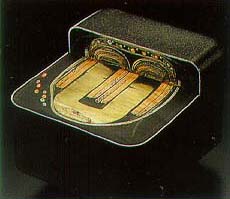
|
Four-gang volume control with CP resistor elements
The volume control uses CP (conductive plastic) resistor elements which
are produced by a printing process followed by a forming stage under high
pressure at high temperature. This creates a mirror-like surface with minimum
contact resistance and negligible distortion. The 8 mm thick brass shaft
is supported by bearings made of a precision machined aluminum block, and
each of the four resistor elements is housed in a precision machined aluminum
case acting as a highly efficient shield. The control uses continuous adjustment
which is the most favorable principle in terms of sound quality. The tracking
error is kept to an amazing 0.5 dB at -60 dB.
|
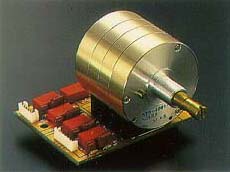
|
Logic-controlled relays for signal switching assure high sound quality
and long-term reliability
The use of logic-controlled relays at strategic locations makes it possible
to keep signal paths extremely short. The relays used in the C-290V are
high-performance hermetically sealed types as used in professional communication
applica-tions. The contacts are twin crossbar types plated with gold and
silver palladium alloy, for mini-mum contact resistance and outstand-ing
long-term reliability.
Vibration-free design with unit amplifiers in aluminum enclosures fastened
to 8-mm hard-ened aluminum chassis
The C-290V has four unit amplifiers, two each for the line input and line
out-put in each channel. Each unit is powered by its own local voltage
regulator circuitry, and is housed in a strong aluminum enclosure, to prevent
interference between units.
Twelve inputs and six outputs with alphanu-meric display
To accommodate today's enormous variety of program sources, the C-290V
offers nine RCA type input pairs, plus three balanced inputs. An alpha-numeric
display on the front panel shows at a glance which input is selected. Six
outputs further add to the versatility of the unit.
Balance control with alphanumeric display
The pushbutton balance control uses 1-dB step attenuators and allows settings
from 0 dB to -6 dB and . The adjustment values are shown on the front
panel.
|
Dedicated phono equalizer unit AD-290V
|
Audiophiles with a collection of analog records will welcome the capability
of the C-290V to reproduce analog discs with sonic quality of the highest
caliber. The separately available phono equalizer unit AD-290V is designed
for simple installation in a dedicated rear-panel slot. The unit uses printed
circuit boards made from Teflon material (glass fluorocarbon resin) and
is housed in a sturdy aluminum case for complete protection against any
external interference. Complementary push-pull circuitry is employed Dedicated
phono equalizer unit AD-290V throughout, with dedicated input stages for
MM and MC cartridges. The MM input uses FET devices with high S/N ratio,
whereas the MC input employs a differential configuration of extremely
low-noise devices, ideal for providing the low impedance required by moving-coil
cartridges with their low output levels. MC input impedance can be switched
in three stages (10/30/100 ohms). MM input impedance is fixed to 47 kilohms.
To match the output of the cartridge, MC gain can be set to 62 or 68 dB,
and MM to 30 or 36 dB. All of these functions can be controlled at the
front panel of the C-290V
|
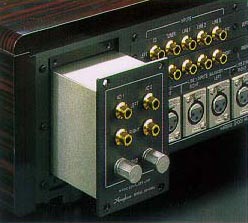
The phono equalizer unit AD-290
designed for the model AD-290 can also be used. |
|
* Guaranteed specifications are measured according to EIA
standard RS-490.
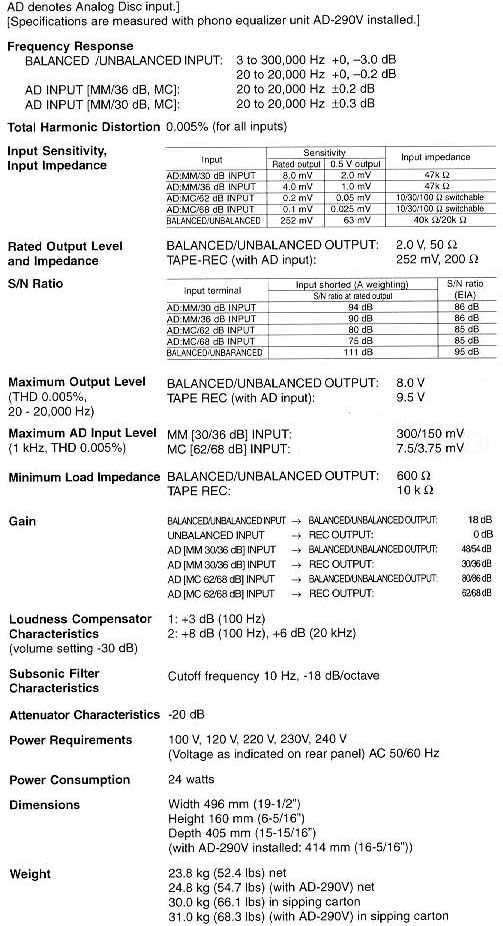
* Specifications and design subject to change without notice for improvements.
|
|
|
|
|
|